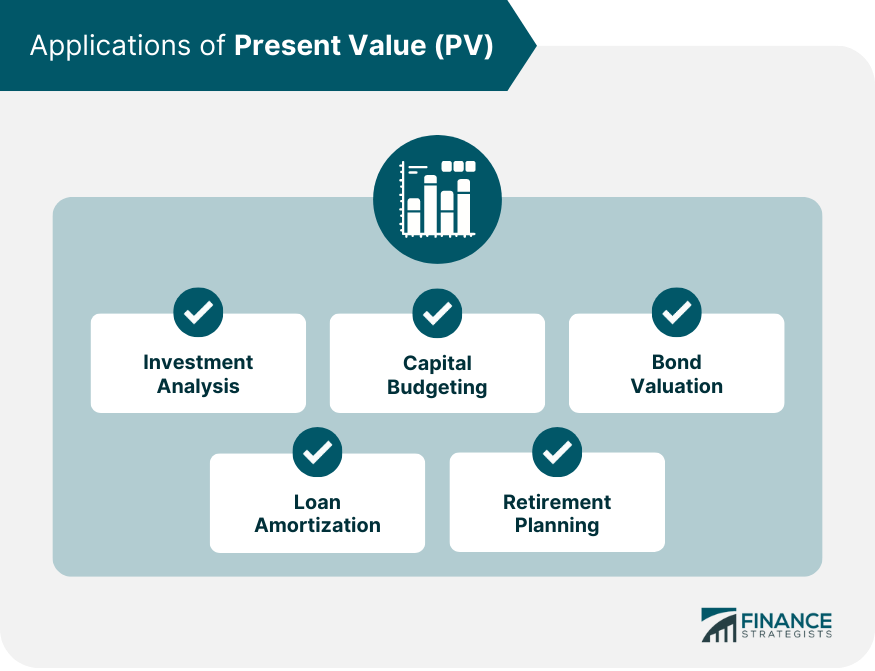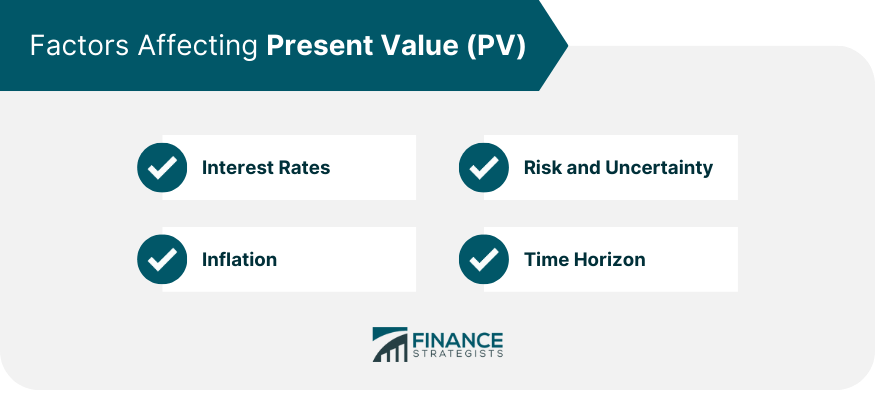Present Value is a financial concept that represents the current worth of a sum of money or a series of cash flows expected to be received in the future. PV takes into account the time value of money, which assumes that a dollar received today is worth more than a dollar received in the future due to its potential earning capacity. The time value of money is a fundamental concept in finance, which states that money available at the present time is worth more than the same amount in the future. This is because of the potential earnings that could be generated if the money were invested or saved. PV is a crucial concept in finance, as it allows investors and financial managers to compare the value of different investments, projects, or cash flows. Understanding PV is essential for making informed decisions about the allocation of resources and the evaluation of investment opportunities. The Present Value formula is calculated using the following components: Future Cash Flow: The amount of money expected to be received in the future. Discount Rate: The interest rate used to discount future cash flows back to their present value. Time Period: The number of periods into the future when the cash flow is expected to occur. The formula for calculating Present Value is as follows: PV = CF / (1 + r)^n Where PV is the Present Value, CF is the future cash flow, r is the discount rate, and n is the time period. Suppose an investor expects to receive $10,000 in five years and uses a discount rate of 5%. Using the Present Value formula, the PV of this future cash flow can be calculated as: PV = $10,000 / (1 + 0.05)^5 = $7,835.26 This means that the current value of the $10,000 expected in five years is $7,835.26, considering the time value of money and the 5% discount rate. PV is used to evaluate and compare different investment opportunities by calculating the present value of their expected future cash flows. This helps investors determine the most profitable investments. Companies use PV in capital budgeting decisions to evaluate the profitability of potential projects or investments. By calculating the present value of projected cash flows, firms can compare the value of different projects and allocate resources accordingly. In bond valuation, PV is used to calculate the present value of future coupon payments and the bond's face value. This information is used to determine the bond's fair market price. PV calculations are used in loan amortization schedules to determine the present value of future loan payments. This information helps borrowers understand the true cost of borrowing and assists lenders in evaluating loan applications. Individuals use PV to estimate the present value of future retirement income, such as Social Security benefits or pension payments. This information helps individuals determine how much they need to save and invest to achieve their desired retirement income. Interest rates have a significant impact on PV calculations. Higher interest rates result in lower present values, as future cash flows are discounted more heavily. Conversely, lower interest rates lead to higher present values. Inflation affects the purchasing power of money over time, which in turn influences the present value of future cash flows. Higher inflation rates reduce the present value of future cash flows, while lower inflation rates increase present value. The level of risk and uncertainty associated with future cash flows can impact the discount rate used in PV calculations. Higher levels of risk and uncertainty typically require higher discount rates, which result in lower present values. Conversely, lower levels of risk and uncertainty lead to lower discount rates and higher present values. The time horizon, or the length of time until a future cash flow is expected to be received, also impacts the present value. The longer the time horizon, the lower the present value, as future cash flows are subject to a greater degree of discounting. While Present Value calculates the current value of a single future cash flow, Net Present Value (NPV) is used to evaluate the total value of a series of cash flows over time. NPV is calculated by summing the present values of all future cash flows, including inflows and outflows, and represents the net benefit of an investment or project. PV is suitable for evaluating single cash flows or simple investments, while NPV is more appropriate for analyzing complex projects or investments with multiple cash flows occurring at different times. Both PV and NPV are important financial tools that help investors and financial managers make informed decisions. PV provides a snapshot of the value of a single future cash flow, while NPV offers a comprehensive assessment of the net value of an investment or project, considering all cash flows over time. PV calculations rely on accurate estimates of future cash flows, which can be difficult to predict. Inaccurate cash flow estimates can lead to incorrect present values, which may result in suboptimal investment decisions. PV calculations are sensitive to changes in the discount rate. Small changes in the discount rate can significantly impact the present value, making it challenging to accurately compare investments with varying levels of risk or uncertainty. PV calculations can be complex when dealing with non-conventional cash flow patterns, such as irregular or inconsistent cash flows. In these cases, calculating an accurate present value may require advanced financial modeling techniques. Present Value is a fundamental concept in finance that enables investors and financial managers to assess and compare different investments, projects, and cash flows based on their current worth. By taking into account factors such as interest rates, inflation, risk, and time horizon, financial professionals can employ Present Value calculations to make informed decisions about resource allocation and investment opportunities. Understanding the applications and limitations of Present Value, including its dependence on accurate cash flow estimation and sensitivity to discount rate changes, is essential for making sound financial decisions. Moreover, it is vital to recognize the differences between Present Value and Net Present Value, as each method serves a unique purpose in financial analysis. While Present Value calculates the current value of a single future cash flow, Net Present Value evaluates the total value of a series of cash flows over time, offering a comprehensive assessment of an investment or project's net value. By utilizing these financial tools effectively, investors and financial managers can optimize their investment portfolios and maximize their returns on investment.What Is Present Value (PV)?
Present Value Formula
Components of the Formula
PV Calculation Examples
Applications of Present Value
Investment Analysis
Capital Budgeting
Bond Valuation
Loan Amortization
Retirement Planning

Factors Affecting Present Value
Interest Rates
Inflation
Risk and Uncertainty
Time Horizon

Present Value vs Net Present Value (NPV)
Definitions and Distinctions
When to Use PV or NPV
Comparison of the Two Methods
Limitations of Present Value
Dependence on Accurate Cash Flow Estimation
Sensitivity to Discount Rate Changes
Challenges With Non-conventional Cash Flow Patterns
Conclusion
Present Value (PV) FAQs
Present value is a financial concept that represents the current value of an expected future sum of money, after accounting for the time value of money and the risk associated with the investment.
PV is calculated by taking the future sum of money and discounting it by a specific rate of return or interest rate. This discount rate takes into account the time value of money, which means that money today is worth more than the same amount of money in the future.
PV is a significant concept in finance, as it helps individuals and businesses to make investment decisions by estimating the current value of future cash flows. By calculating the PV of potential investments, investors can determine if an investment is worth pursuing or if they would be better off pursuing alternative investment opportunities.
The primary factors that affect PV include the interest rate or discount rate used in the calculation, the length of time until the expected future cash flow is received, and the risk associated with the investment. Generally, a higher interest rate will result in a lower PV, while a longer time horizon or higher risk will result in a lower PV.
PV is commonly used in a variety of financial applications, including investment analysis, bond pricing, and annuity pricing. It is also used to evaluate the potential profitability of capital projects or to estimate the current value of future income streams, such as a pension or other retirement benefits.
True Tamplin is a published author, public speaker, CEO of UpDigital, and founder of Finance Strategists.
True is a Certified Educator in Personal Finance (CEPF®), author of The Handy Financial Ratios Guide, a member of the Society for Advancing Business Editing and Writing, contributes to his financial education site, Finance Strategists, and has spoken to various financial communities such as the CFA Institute, as well as university students like his Alma mater, Biola University, where he received a bachelor of science in business and data analytics.
To learn more about True, visit his personal website or view his author profiles on Amazon, Nasdaq and Forbes.















